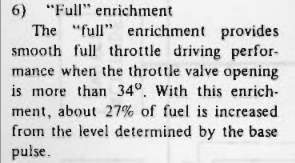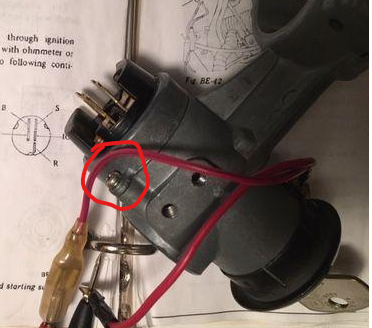Everything posted by Zed Head
-
Parts needed for 280Z R200 CV axle swap?
I'd use the u-joint half-shafts that you have. Get a zerk fitting, remove the little screws and lube them up. They'll probably last another 40 years. The "CV" half-shafts are not really much better than the u-joint shafts. They're probably cheaper to manufacture, maybe why Nissan switched.
-
What engine do I have?
Here is Overkill https://forums.hybridz.org/topic/67320-the-start-of-the-bcustoms-z-has-begun2jz-1000hp/#comments
-
What engine do I have?
Bone dust? Who's crushing bones? You really should consider just buying a used engine if you just want to get it driving. There is a lot to learn before extracting power from the little L28. And a lot to do to the car to make it drivable without breaking things. You can drive it while you plan your master build. Otherwise it will probably sit, maybe for years, while you figure out how to make and use all of that power. Nothing wrong with that though, it happens.
-
Fuel Pump Issues... AGAIN
If you're working with the pins on the bottom of the relay you might consider just taking the relay apart and watching what happens. With the top off you can easily see which wires actuate the relay coils. Several of us have found fried/burned coils inside our relays boxes. I have a picture of one that was full of rust. Just pry the tabs back that hold the top on and pop it off.
-
Duffy's 1/71 Series 1 240z build
That looks like a nice setup. If I was building mine today Id probably try it. Looks adjustable but with vacuum regulation. Very nice, Where's the picture of yours?... Let us dream. http://www.radiumauto.com/DMR-Direct-Mount-Regulator-P909.aspx Looks like they sell dampers also. http://www.radiumauto.com/Fuel-Pulse-Damper-Direct-Mount-Kits-P759.aspx
-
1973 Rebuild
You can measure and probably find a reasonable substitute. But they shouldn't really need replacement, unless they were damaged during removal. They are designed as springs, a few cycles won't hurt them.
-
280Z Requires Starting Fluid for Cold Starts
Could also be retarded timing. Make sure timing advances with RPM. You can check that with a light, non-driving.
-
280Z Requires Starting Fluid for Cold Starts
-
L28 from 82 ZX teardown
Your brain took a wheee? Was that wrong? It feels wrong.
-
280Z Requires Starting Fluid for Cold Starts
I was going to mention this earlier. Others have noticed that some ignition switches have a break between Run and Start and others don't, I think it was early compared later. Can't remember which is which, old versus new, but I think that SteveJ @SteveJ dug in to a bit. If I recall, it was decided that it din't really matter much. Corroded connections can open up once current starts flowing and creates some heat. You've found a potential cause for your problem, or a potential cause for some melted wires in the future. Keep cleaning.
-
Website help needed
I put one in for you and Mike replied. He's on it...
-
Failed CO emissions - all controls removed - where to start?
There's a small mini-harness that's missing. Get a fuel injector plug (it fits the coolant temperature sensor) and some wire and some bullet connectors and make your own. You need that circuit. Older BMWs and Volvos and Saabs use the EV1 type connector, if you want to make a quick wrecking yard trip. Or there's the internet. https://www.amazon.com/Fuel-Injector-Connector-Type-Pigtail/dp/B01M0GCLZP
-
Website help needed
Maybe he's in Japan...
-
Website help needed
Did you try the Support link? It used to be on the forums page but looks like Mike moved it to its own special place. @Mike https://www.classiczcars.com/support/
-
Failed CO emissions - all controls removed - where to start?
There are two bullet connectors in the harness between the sensor itself and the ECU. Trace the wires back from the sensor. Measure resistance at the sensor itself. Can't tell if you did that. If your wires aren't right a new sensor won't make a difference. If the engine starts and runs with no coolant sensor reading then you probably have a bunch of "resetting" ahead of you. Other stuff has probably been messed with, most likely the AFM, or maybe there's a big vacuum leak somewhere.. The coolant temperature sensor is one of the most important sensors in the system.
-
What is this hole??
And, if the metal is thin there you won't have enough to form threads if you decide to drill and tap. Just be sure you have a solid plan before you start.
-
What is this hole??
Don't over-complicate things. ~14 psi coolant mixture is all it needs to seal. The bigger you make the hole the more difficult it will be to seal. You could probably put a piece of tape over it and the manifold force on top of the tape would keep it sealed. Or even just a blob of silicone as you place the gasket. It's not a head gasket leak, it's just a coolant leak.
-
What is this hole??
CO is right. I picked the wrong hole. Is there a similar hole on the other side of the head? Pins for porting or gasket matching seems likely. It's shooting a nice big round stream for a corrosion hole. Seems like it was drilled on purpose.
-
What is this hole??
Head might be cracked or somebody has drilled a broken bolt out of that hole and went too far. Look in the hole.
-
What is this hole??
Isn't that hole threaded? If I recall correctly that hole is for areas that still used carbs like Europe and Australia. It's a carb mount hole I think. Odd that yours leaks. You might have a cracked head or somebody drilled through the bottom of the hole for some reason. If you're sure the head isn't cracked you could just run a threaded allen-head plug in to it with some sealer. Try to see down the hole to where the coolant is getting in. If it's from the bottom probably not a big deal. If it's from the side then probably a problem. Short answer is it shouldn't be leaking from that hole.
-
1971 HLS30-14938 "Lily" build
-
What is this hole??
There are a lot of holes in your picture. Pick one.
-
What engine do I have?
That's not a bad idea. Consider just buying an unmolested secondhand motor though, if you want to avoid a PO's mistakes. These engines can go high miles before needing any work. There are still many engines out there that haven't been opened since they were sealed at the Nissan factory. You could buy a whole car and probably come out ahead of fixing a PO's mistakes.
-
Trouble-shoot directions for ignition/no start
I repaired one once. It depends on what's wrong with it. The two red wires are for the steering lock switch. You want to test between the pins on the end of the switch, using the chart with B, S, IG, and A. The circles with a line between them indicate when there should be continuity. You can also plug it back in turn the electrical part alone. I had a switch that would not turn the electrical part far enough. I had to twist the rod between the mechanical and electrical parts. Take the two screws out and use a screwdriver to turn the electrical switch. You'll see the little flat rod that turns it when you take it apart. You might have to destroy one of the screws, Nissan made them one time use as an anti-theft measure.
-
280Z Requires Starting Fluid for Cold Starts
We're in the very common troubleshooting loop of "I already did that". You're about at the point where you just have to understand how the system works. The first few pages of the engine fuel chapter tell you what is supposed to happen. The injectors open when the power is grounded, they stay open for a length of time that is determined by things like temperature and how far open the AFM vane is, etc. Once you start thinking that way you'll have new ideas. Seems like you've done a bunch already that you haven't described, and haven't done some of the things that have been suggested, like confirming power to the injectors during starting. Good luck.









